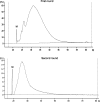Real-time monitoring of aRNA production during T7 amplification to prevent the loss of sample representation during microarray hybridization sample preparation
- PMID: 19336411
- PMCID: PMC2677895
- DOI: 10.1093/nar/gkp193
Real-time monitoring of aRNA production during T7 amplification to prevent the loss of sample representation during microarray hybridization sample preparation
Abstract
Gene expression analysis performed through comparative abundance of transcripts is facing a new challenge with the increasing need to compare samples of known cell number, such as early embryos or laser microbiopsies, where the RNA contents of identical cellular inputs can by nature be variable. When working with scarce tissues, the success of microarray profiling largely depends on the efficiency of the amplification step as determined by its ability to preserve the relative abundance of transcripts in the resulting amplified sample. Maintaining this initial relative abundance across samples is paramount to the generation of physiologically relevant data when comparing samples of different RNA content. The T7 RNA polymerase (T7-IVT) amplification is widely used for microarray sample preparation. Characterization of the reaction's kinetics has clearly indicated that its true linear phase is of short duration and is followed by a nonlinear phase. This second phase leads to modifications in transcript abundance that biases comparison between samples of different types. The impact assessment performed in this study has shown that the standard amplification protocol significantly lowers the quality of microarray data, rendering more than half of differentially expressed candidates undetected and distorting the true proportional differences of all candidates analyzed.
Figures








Similar articles
-
Amplified RNA degradation in T7-amplification methods results in biased microarray hybridizations.BMC Genomics. 2003 Nov 10;4(1):44. doi: 10.1186/1471-2164-4-44. BMC Genomics. 2003. PMID: 14606961 Free PMC article.
-
Validation and application of a high fidelity mRNA linear amplification procedure for profiling gene expression.Vet Immunol Immunopathol. 2005 May 15;105(3-4):331-42. doi: 10.1016/j.vetimm.2005.02.018. Vet Immunol Immunopathol. 2005. PMID: 15808310
-
Optimized T7 amplification system for microarray analysis.Biotechniques. 2001 Oct;31(4):874-9. doi: 10.2144/01314mt05. Biotechniques. 2001. PMID: 11680719
-
Options available for profiling small samples: a review of sample amplification technology when combined with microarray profiling.Nucleic Acids Res. 2006 Feb 9;34(3):996-1014. doi: 10.1093/nar/gkj499. Print 2006. Nucleic Acids Res. 2006. PMID: 16473852 Free PMC article. Review.
-
Expression profiling using human tissues in combination with RNA amplification and microarray analysis: assessment of Langerhans cell histiocytosis.Amino Acids. 2005 May;28(3):279-90. doi: 10.1007/s00726-005-0177-x. Epub 2005 Mar 30. Amino Acids. 2005. PMID: 15791395 Review.
Cited by
-
Use of non-amplified RNA samples for microarray analysis of gene expression.PLoS One. 2012;7(2):e31397. doi: 10.1371/journal.pone.0031397. Epub 2012 Feb 15. PLoS One. 2012. PMID: 22355363 Free PMC article.
-
Do-it-yourself: construction of a custom cDNA macroarray platform with high sensitivity and linear range.BMC Biotechnol. 2011 Oct 25;11:97. doi: 10.1186/1472-6750-11-97. BMC Biotechnol. 2011. PMID: 22026914 Free PMC article.
-
Transcriptome Profiling of In-Vivo Produced Bovine Pre-implantation Embryos Using Two-color Microarray Platform.J Vis Exp. 2017 Jan 30;(119):53754. doi: 10.3791/53754. J Vis Exp. 2017. PMID: 28190024 Free PMC article.
References
-
- Kurn N, Chen P, Heath JD, Kopf-Sill A, Stephens KM, Wang S. Novel isothermal, linear nucleic acid amplification systems for highly multiplexed applications. Clin. Chem. 2005;51:1973–1981. - PubMed
-
- Puskas LG, Zvara A, Hackler L, Jr, Van Hummelen P. RNA amplification results in reproducible microarray data with slight ratio bias. Biotechniques. 2002;32:1330–1334. 1336, 1338, 1340. - PubMed
Publication types
MeSH terms
Substances
LinkOut - more resources
Full Text Sources
Molecular Biology Databases

